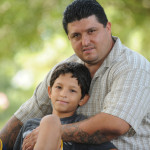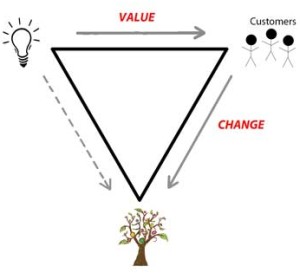“Many inmates come to prison as seasoned entrepreneurs who happened to run illegitimate businesses.”
www.PEP.org
| Offering | In-Prison Entrepreneurship “Bootcamp.”
For Graduates: Lifetime Support Upon Prison Release |
|---|---|
| Value Proposed | To Inmates: Engage strengths toward legal enterprise.
|
| Key Resources Leveraged by Way of Offering: | i. Demonstrated entrepreneurial talent of certain inmates.
ii. Program founder’s knowledge of entrepreneurship, including scouting-type skill at recognizing others’ skill and strengths. iii. Volunteer executives’ experience & time. iv. Philanthropic dollars. The better the offering works, the more effect there is from the same dollars. |
| Societal Progress | “People.” (Direct effect.)
“Profit.” (Indirect effect — Assumes released inmates contribute to economy more robustly than without the program.) |
1. Agent’s Path to Offering
Observing incongruity. Associated with underutilized resource of human strengths:
- “Expecting prison to be a place filled with wild, caged animals, (the PEP founder) was cut to the core to find prisoners who were deeply human—passionate, moldable men thirsty for change. (She) immediately recognized their ROI [return on investment] potential …
- (P)rison inmates—especially former gang leaders, drug dealers and those with violent offenses—have a massive reservoir of untapped potential. Their latent potential once expressed itself in illegitimate business endeavors e.g., gang-related crime, drug dealing and violent crime.”
2. Hypothesis: “What Could Be as New Value”
“What if she equipped these men [inmate customers] with legitimate business skills?”
What if “these men (were redirected) into legitimate enterprises, leveraging their proven entrepreneurial skill-sets to inspire an even deeper change”?
Sample Knowledge Connected in “What Could Be” Hypothesis:
Domain Knowledge (Entrepreneurship)
- Deep knowledge of entrepreneurship includes lens for recognizing talent.
- “Some prisoners share essential traits with business executives.” They represent “(s)ome of the hungriest entrepreneurs in the country.”
Customer Knowledge
- “Many inmates come to prison as seasoned entrepreneurs who happened to run illegitimate businesses.”
- Understanding customers’ barriers to legitimate expression of strengths.
Human-Social Knowledge
- Understanding the force of human value for engaging one’s signature strengths.
3. “How” Hypotheses
 Overall — Establish a new non-profit organization that: (i) partners with state’s Department of Criminal Justice; and (ii) catalyzes support from those who understand entrepreneurship and share value for it (especially donors & business executives as program volunteers)
Overall — Establish a new non-profit organization that: (i) partners with state’s Department of Criminal Justice; and (ii) catalyzes support from those who understand entrepreneurship and share value for it (especially donors & business executives as program volunteers)
“We’re connectors—uniting CEOs, investors and graduates through entrepreneurial passion to incite measurable change.”
Enterprise Model:
| End Customers: | Customer Relationships: |
| Inmates. Those with demonstrated entrepreneurship strengths. |
Advocate, Teach Mentor, Connect |
| Key Activities: |
Channels: |
| Program Management (Design, Recruit, Manage Relationships, etc.) |
Prisons. Initially one prison. Evolved to dedicated facility to support statewide recruiting at 60+ prisons. |
| Key Partners: |
Key Resources: |
| State of Texas Department of Criminal Justice | Prisoner Talent/Strengths. Executive Volunteers. Prisoner Families. Other Program Volunteers. |
| Key Costs: | Revenue Streams: |
| Limited Paid Staff. Programming Costs. Sample Cost Avoided: Facilities. |
Donations |
Sample Knowledge Connected in “How” Hypotheses:
Domain Knowledge — Deep Entrepreneurship Knowledge
- Fundamental to program content & resourceful day-to-day management
- Allowed for hypothesizing the “value” that participation would represent to business executive volunteers, donors, etc.
Customer Knowledge — Inmates:
- Understanding customers as entrepreneurs allowed for designing effective Bootcamp content & entrepreneurship support following release.
- Understanding customers as prisoners, especially recognizing vulnerabilities, allowed for separate aspects of program design. For example: (i) separate cell blocks from other inmates & eventually one dedicated prison facility; (ii) structured family support upon release.
Industry Knowledge — Corrections:
- Nature of status-quo prison influences: “Prison isn’t just an economic drain, but a human one as well.”
- Importance of buffering inmate customers from status-quo prison influences: “Prison makes personal change difficult.”
- Nature of release challenges. For example: “Studies show that inmates are most vulnerable and impressionable within the first 72 hours following release.”
- Hypothesizing value of program to inmate families. For example: “The most dubious about prisoners’ potential to change; also the most hopeful and a potential source of catalyzing support.”
Human & Social Dynamics
- Hypothesis that executives/mentors possess latent value for their own self-transformation — linked to human value for *meaning* of connection to a cause beyond oneself.
- Value for opportunities to repair/strengthen strained family relations.
4. Change by Way of Value
 Outcomes:
Outcomes:
Success with initial operation inside one prison facility led to statewide expansion.
Innovation agents decided to keep operations inside the state.
Type of New Yield on Resources:
Well-Being. “People”
- The strengths of the customers themselves are the fundamentally underutilized resources to generate the fruit of greater well-being, both, for customers and more broadly.
- In realizing this change, the value of the offering needed to catalyze not only inmate adoption (plus catalyze support of volunteers, donors, state government, etc.), the offering also needed to produce change in customer behavior and/or capability.

5. Why the PEP Agents Do This Work
Value:
Engagement of their own strengths.
Meaning: “How can I match my intrinsic talent with one of the world’s deep needs?”
Founder’s Innovation “Persona”:
“Director”

